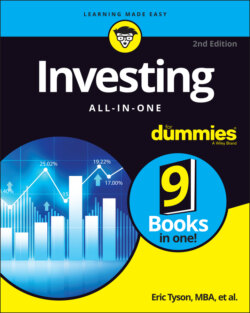Читать книгу Investing All-in-One For Dummies - Eric Tyson - Страница 57
What the heck is “quantitative easing”?
ОглавлениеDuring and after the 2008 financial crisis, many pundits interviewed on financial cable television programs and website pontificators used the Federal Reserve as a punching bag, blaming the Fed for various economic problems, including the 2008 financial crisis. Despite the rebounding economy and stock market, some of the critics got even more vocal in blasting the Fed’s quantitative easing program begun late in 2010. (It’s worth noting that this program was again used in 2020 during the COVID-19 pandemic and government-mandated economic shutdowns.)
More often than not, these critics, who typically and erroneously claim to have predicted the 2008 crisis, have an agenda to appear smarter than everyone else, including the Fed. Some of these pseudo-experts are precious metals hucksters and thus like to claim that the Fed is going to cause hyperinflation that will impoverish you unless you buy gold, silver, and the like.
In one popular video from 2010 that has millions of views on YouTube, the author claims the following using goofy cartoonish characters:
The Fed is printing a ton of money to implement quantitative easing (QE).
QE is being done to stop deflation (falling prices), but the Fed is too dumb to realize that consumer prices are rising, not falling.
The Fed has been wrong about everything the past 20 years.
Then Fed Chairman Ben Bernanke is unqualified for his job because he has no business experience, has no policy experience, and has never held an elected office. He is a fool who’s been wrong about everything during his tenure in office and has already blown up the American economy and is now working on blowing up the world economy.
The government is stupidly buying Treasuries from Goldman Sachs at grossly inflated prices (rather than buying Treasuries from the Treasury department). Goldman Sachs is ripping off the American people.
Although it’s stunning in and of itself that this video has been watched millions of times, even more amazing and disturbing is how many mainstream media and other websites and outlets have promoted and recommended the video, making little if any effort to fact-check and reality-check its contents. Here we set the record straight and advance your understanding of what quantitative easing really is and why the Fed is doing it. We go through the video’s main assertions point by point:
The Fed is not printing a ton of money (expanding the money supply) to implement QE. Retail money market assets and bank deposits could increase, for example, if individuals decided to hold more cash. Demand for these highly liquid assets can come from folks around the world, so increased demand for the U.S. dollar during times of stress can lead to the growth of M2 (the leading measure of the money supply). Changes in money supply are complicated.
The Fed is well aware that there’s inflation right now but has been concerned that the rate has been quite low by historical standards and that there were signs of accelerating deflation during the severe recession.
If the Fed had been wrong about everything the past 20-plus years, our economy would be in shambles and our stock market wouldn’t have appreciated more than 1,400 percent since 1990. Before the COVID-19 pandemic and government-mandated shutdowns, the U.S. unemployment rate was at a 50-year low at 3.5 percent.
Bernanke was well qualified for his job.
The Fed is buying Treasuries from banks at competitive prices and is doing so to encourage more bank lending. Saying that the Fed is directing this buying solely to Goldman Sachs is absurd. The Fed conducts such Treasury open market operations through an approved list of 18 primary dealers, and Goldman is one of the 18 dealers operating in a highly competitive environment. Goldman bashing has been going on for a long time.
Interestingly, there hasn’t been much questioning of the background and agenda of the person behind this fact-challenged YouTube video, who in some articles is referred to as a “30-year-old real estate manager.” He has no discernible background or expertise in the subject matter discussed in the video, which helps explain why nearly every statement in the video is wrong.
In various speeches and selected interviews, former Fed Chairman Bernanke has explained QE. Here’s one fairly plain English explanation that Bernanke gave during the height of the credit crisis (Note: “Central bank” means the Federal Reserve):
Quantitative easing can be thought of as an expansion of the central bank’s balance sheet with no intentional change in its composition. That is, the central bank undertakes more open market operations with the objective of expanding bank reserve balances, which the banking system should then use to make new loans and buy additional securities. However, when credit spreads are very wide, as they are at present, and the credit markets are quite dysfunctional, it becomes less likely that new loans and additional securities purchases will result from increasing bank reserve balances.
In contrast, credit easing focuses on the mix of loans and securities that the central bank holds as assets on its balance sheet as a means to reduce credit spreads and improve the functioning of private credit markets. The ultimate objective is improvement in the credit conditions faced by households and businesses. In this respect, the Federal Reserve has focused on improving functioning in the credit markets that are severely disrupted and that are key sources of funding for financial firms, nonfinancial firms, and households.
